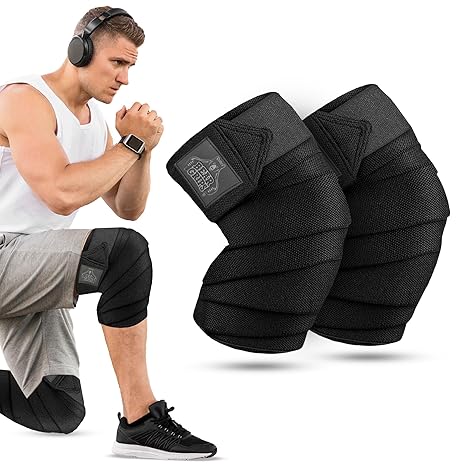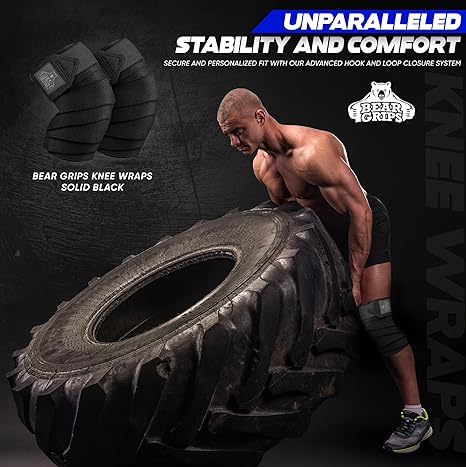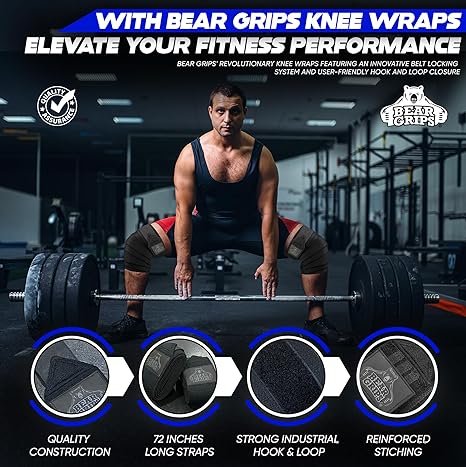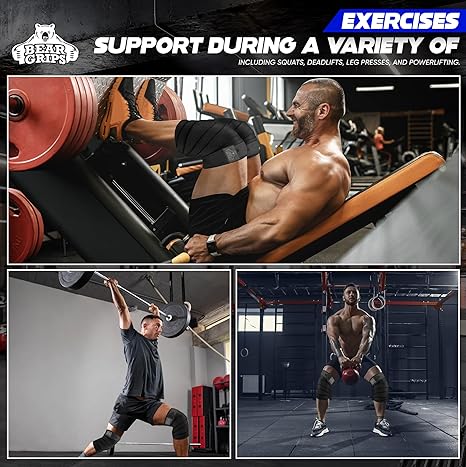
How to use Wrap Knee Wraps for Powerlifting
Share
For powerlifters, proper knee wrapping is essential to maximize support, enhance lifts, and prevent injuries. In this article, we will provide a step-by-step guide on how to wrap knee wraps for powerlifting, ensuring you utilize the correct technique and achieve optimal results.
Before we dive into the details, let's first understand the importance of using the right knee wrapping technique.
Key Takeaways:
- Proper knee wrapping is crucial for powerlifters
- Using the correct technique enhances support and prevents injuries
- Follow a step-by-step guide to wrap knee wraps effectively
- Selecting the right knee wraps is essential for optimal results
- Maximize carryover by learning to use knee wraps effectively
Importance of Proper Knee Wrapping Technique
Using the correct knee wrapping technique is crucial for powerlifters to optimize their lifts and prevent injuries. Many lifters may not know the proper way to wrap their knees, leading to ineffective support. When knee wraps are not applied correctly, they fail to provide the necessary stability and compression needed during heavy lifts, compromising performance and putting the knees at risk.

The primary objective of knee wraps is to provide external support to the knee joint and enhance proprioception, allowing lifters to feel more secure and confident during their lifts. Properly wrapped knee wraps act as a mechanical advantage, helping powerlifters generate more force, recruit more muscle fibers, and overcome sticking points in the squat. They can also assist in reducing unnecessary stress on the knee joint, preventing common powerlifting injuries such as patellar tendonitis and meniscus damage.
To emphasize the significance of using the right technique when wrapping knee wraps, let's take a closer look at some key advantages:
1. Enhanced Stability and Support: Properly wrapped knee wraps provide a secure and stable foundation for powerlifters, especially during heavy lifts. They help preserve knee alignment, distribute the load evenly, and reduce the risk of collapsing or caving inwards during the squat.
2. Increased Power Output: The correct wrapping technique ensures optimal tightness, allowing lifters to generate more power and force through their legs. This results in increased joint support and the ability to lift heavier weights.
3. Improved Confidence: When lifters feel supported and secure in their knee wraps, they can focus on executing the lift with confidence. This mental boost can lead to improved performance and the ability to push through challenging lifts.
Mastering the proper knee wrapping technique is vital for powerlifters who want to maximize their lifts and minimize the risk of injury. In the next section, we will provide a comprehensive step-by-step guide on how to wrap knee wraps for powerlifting, ensuring you have the knowledge and skills to apply the wrapping technique correctly.
Step-by-Step Guide to Wrapping Knee Wraps
Properly wrapping knee wraps is crucial for powerlifters to ensure optimal support and stability during their lifts. This step-by-step guide will walk you through the process of wrapping knee wraps for powerlifting, providing you with the necessary techniques and tips to get it right.
Gather Your Materials
Before you begin, make sure you have the following materials:
- Knee wraps
- Towel or knee sleeves
Step 1: Roll Your Wraps
Start by rolling your knee wraps tightly. This will make it easier to apply them and ensure a snug fit when wrapping your knees.
Step 2: Position the Wraps
Stand with your feet shoulder-width apart and straighten your legs. Place the rolled wraps behind your knees, making sure they are centered.
Step 3: Wrap Below the Kneecap
Take one end of the wrap and wrap it tightly around the lower part of your leg, just below the kneecap. Make sure the wrap is snug but not too tight, allowing for proper circulation.
Step 4: Wrap Above the Kneecap
Continue wrapping the wrap above the kneecap, overlapping the previous wrap with each revolution. Aim for a 50% overlap to ensure optimal support and stability.
Step 5: Cross or Straight?
Choose between the straight or crossover wrapping style, depending on your personal preference and comfort. The straight style involves wrapping the wraps parallel to each other, while the crossover style involves crossing the wraps over each other as you wrap.
Step 6: Secure the Wraps
Once you have wrapped the desired number of revolutions, secure the wraps in place by tucking the end into the wrap or using the Velcro straps provided.
Remember to repeat the same steps for the other knee to ensure symmetrical support and stability. Take note of any discomfort or tightness, as this may indicate that the wraps are too tight or have been wrapped incorrectly.
By following this step-by-step guide, you can confidently wrap your knee wraps for powerlifting, providing the necessary support and stability to enhance your lifts safely and effectively.

Selecting the Right Knee Wraps
Choosing the right knee wraps is a crucial decision for powerlifters aiming to achieve optimal support during their lifts. The right knee wraps can provide the stability and compression necessary for maximizing performance and preventing injuries. When selecting knee wraps, there are several factors to consider:
Strength Level
Powerlifters have varying strength levels, which can influence the type of knee wraps that suit their needs. For beginners or lifters with lower strength levels, it is advisable to start with lighter and less restrictive knee wraps. These allow for a gradual adaptation to the support provided by the wraps while still maintaining the development of raw strength.
Wrap Tightness
Wrap tightness is an essential consideration when selecting knee wraps. The tightness of the wrap affects the level of support and compression provided to the knees. Tighter wraps offer more stability and support but may limit mobility. It is crucial to find a balance between tightness and comfort that suits individual preferences and meets the demands of different lifts.
Building Raw Strength
Before incorporating knee wraps into training, it is recommended to build a base of raw strength. Developing raw strength without the reliance on knee wraps helps enhance overall stability and ensures that the lifter has a strong foundation to support the added benefits of knee wraps. Once a solid base of strength is established, knee wraps can be introduced gradually to enhance performance.
Experts' Recommendations
To help guide powerlifters in selecting the right knee wraps, experts in the powerlifting community have extensively tested and reviewed various options. Based on their recommendations and feedback, these are some highly regarded knee wrap brands:
- Titan Knee Wraps
- SBD Knee Wraps
- Inzer Knee Wraps
- Schiek Knee Wraps
These brands have consistently been praised for their durability, support, and effectiveness in powerlifting. It is advisable to explore different options and consider personal preferences and requirements when choosing knee wraps.
Remember, selecting the right knee wraps is a personal decision that should take into account factors such as strength level, wrap tightness, and the importance of building raw strength. By choosing the appropriate knee wraps, powerlifters can enhance their performance, protect their knees, and reach new heights in their lifting journey.
Maximizing Carryover with Knee Wraps
Knee wraps play a crucial role in powerlifting by providing carryover, enabling lifters to handle heavier weights during squats. To fully harness the benefits of knee wraps, it is essential to understand how to use them effectively. By incorporating specific technical components into your training and implementing wrapped and raw cycles strategically, you can maximize carryover and push your lifts to new heights.
When training with knee wraps, it's important to focus on the following technical aspects:
- Tension: Applying the correct tension to knee wraps is crucial for optimal performance. Striking the right balance between tightness and flexibility will allow you to generate maximal power while maintaining stability during the descent and ascent of a squat.
- Placement: Properly positioning knee wraps is key to achieving the desired effects. Wrapping below and above the kneecap in a consistent and snug manner will provide the necessary support and stability to enhance your lifts.
- Technique: Learning the correct wrapping technique is vital. Whether you prefer a straight or crossover style, understanding the nuances of each method will help you optimize the benefits of knee wraps and reduce the risk of injury.
By mastering these technical components, you can ensure that your knee wraps are effectively maximizing carryover and enhancing your performance in squats.
Another technique to consider for maximizing carryover is staggering wrapped and raw cycles. This approach involves alternating between training phases where you exclusively use knee wraps and periods where you train without them. Staggering wrapped and raw cycles allows you to build strength and develop specific aspects of your squat technique in both wrapped and unwrapped conditions.
Not only does this training strategy prevent over-reliance on knee wraps, but it also helps strengthen your raw squat, further improving your overall performance. By experiencing the contrast between wrapped and raw lifting, you can identify weaknesses, fine-tune your technique, and promote well-rounded development.
Powerlifters who master the art of maximizing carryover with knee wraps have a significant advantage. The ability to handle heavier weights during squats translates into increased strength and performance. Implementing the proper technical components and utilizing staggered wrapped and raw cycles in your training regimen will empower you with the tools to push your limits and achieve new personal bests.

Wrapping Wrist Wraps for Powerlifting
Alongside the use of knee wraps, powerlifters frequently rely on wrist wraps during bench press and squats to provide crucial support and protect the wrist joint. Properly wrapping the wrists is essential in powerlifting, as it not only helps in maintaining stability but also reduces the risk of injuries.
When it comes to wrapping wrist wraps for powerlifting, it is vital to follow a proper technique that ensures optimal support and effectiveness. Starting with a tight wrap around the wrist joint, the wrap should be secured with a few rotations around the wrist, followed by extending the wrap towards the palm while making sure it remains taut.
The benefits of wrist wrapping in powerlifting cannot be overstated. Wrist wraps enhance grip strength, enabling powerlifters to exert maximum force during heavy lifts. They also provide stability to the wrist joint, reducing the risk of strain and injury. Additionally, wrist wraps can alleviate wrist discomfort that may arise from prolonged and intense training sessions.
However, it is important to note that improper technique or excessive reliance on wrist wraps can lead to issues such as limited mobility and weakness in the wrist muscles. Thus, it is recommended to use wrist wraps judiciously, supplementing them with exercises that strengthen the wrist and forearm muscles.
Proper wrist wrapping not only benefits powerlifters during bench press and squats but also has a positive impact on other compound movements that require wrist stability. By ensuring proper technique and incorporating wrist wraps strategically into their training routines, powerlifters can enhance their performance and protect their wrists.
Expert Tip:
When wrapping wrist wraps for powerlifting, remember to keep the wraps snug but not overly tight. This will provide the necessary support without compromising blood flow or causing discomfort.
Now that we have covered the importance of wrist wrapping in powerlifting, let's move on to the next section, where we will delve into valuable insights on selecting the right knee wraps for optimal performance.
Conclusion
Properly wrapping knee wraps and wrist wraps is essential for powerlifters to enhance their lifts safely and efficiently. Throughout this comprehensive guide, we have emphasized the importance of technique, wrap selection, and maximizing carryover in powerlifting.
By following the step-by-step guide on how to wrap knee wraps, powerlifters can ensure optimal support and prevent injuries. The correct wrapping technique, starting from behind the knee, wrapping below and above the kneecap, and understanding the difference between straight and crossover wrapping styles, is crucial for effective support during heavy lifts.
Additionally, selecting the right knee wraps based on your strength level, wrap tightness, and understanding the importance of developing a strong foundation of raw strength is key to maximizing your performance. We have provided expert recommendations based on extensive testing to help you make an informed choice.
Furthermore, we discussed the benefits of wrapping wrist wraps for bench press and squats, which can provide additional support and protect your wrist joint from potential injuries. Wrapping your wrists correctly can also have a positive impact on reducing elbow and shoulder pain during your lifts.
By following the guidelines outlined in this guide, powerlifters can optimize their training and ensure they are equipped with the knowledge and techniques needed to achieve their lifting goals.
Buy the best knee wraps from Bear Grips today!
Shop Now at Amazon.com.
FAQ
Why is it important to use the correct knee wrapping technique when powerlifting?
Using the correct knee wrapping technique is essential for powerlifters to optimize their lifts and prevent injuries. Incorrect wrapping can lead to ineffective support and potential harm.
What is the step-by-step process for wrapping knee wraps for powerlifting?
The step-by-step process for wrapping knee wraps includes rolling the wraps, starting from behind the knee, wrapping below and above the kneecap, and understanding the difference between straight and crossover wrapping styles.
What factors should be considered when choosing knee wraps for powerlifting?
When selecting knee wraps, factors such as strength level, wrap tightness, and building a base of raw strength before using wraps should be considered. Expert testing within the powerlifting community can also provide recommendations for specific knee wrap brands.
How can carryover be maximized using knee wraps?
Carryover can be maximized by training in knee wraps, focusing on specific technical components, and considering the benefits of staggering wrapped and raw cycles.
Why is wrapping wrists important for powerlifters?
Wrapping wrists for powerlifting, especially during bench press and squats, provides support and helps protect the wrist joint. The proper wrapping technique can also have an impact on reducing elbow and shoulder pain.


